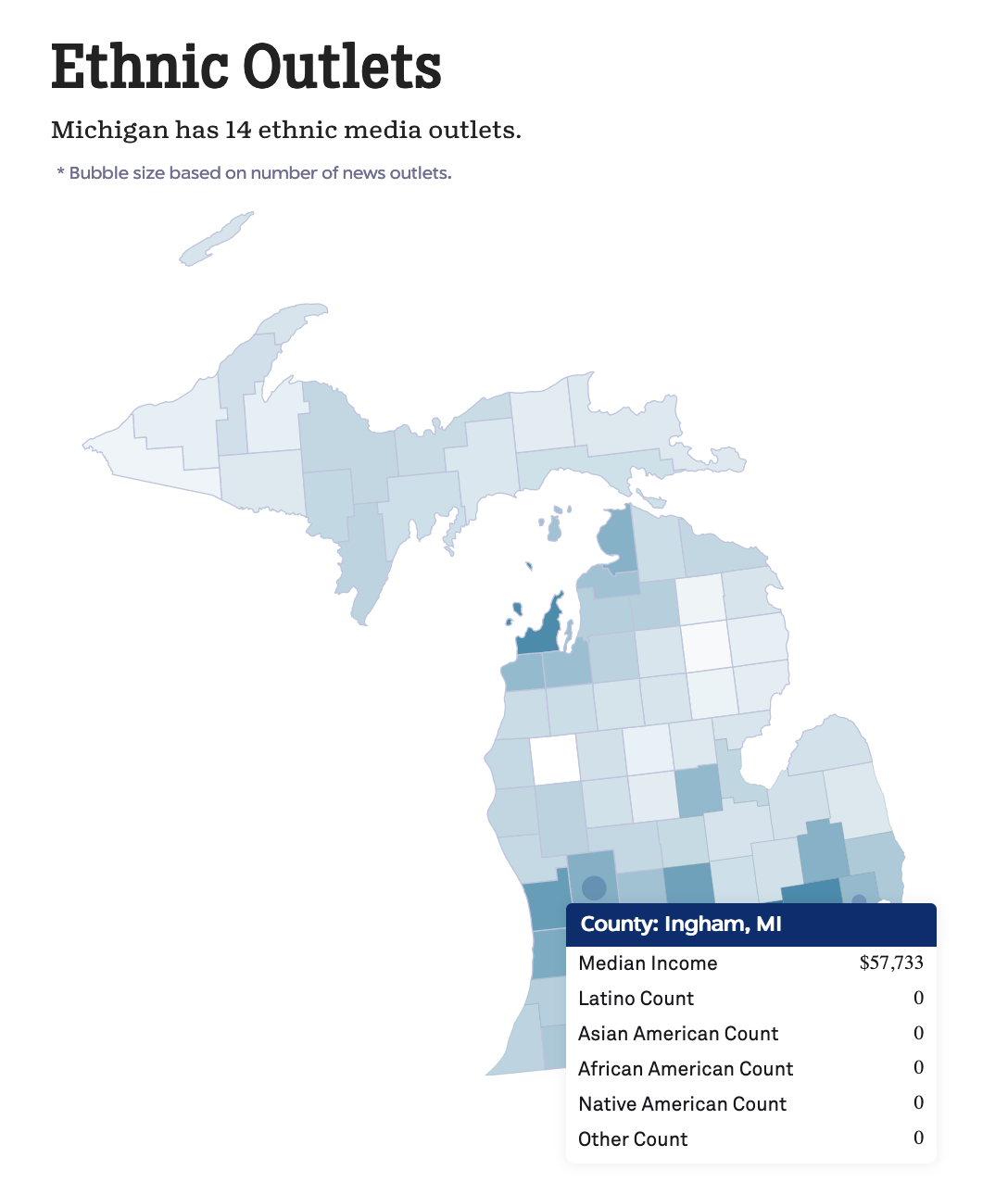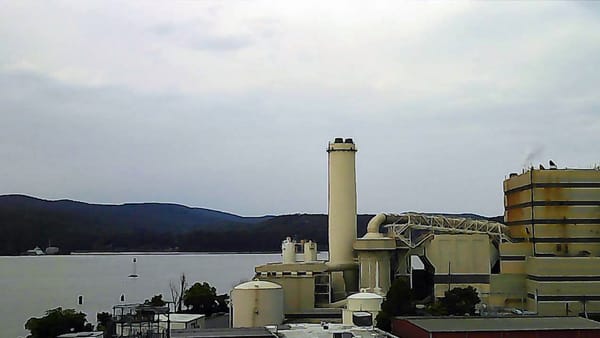The Literally Impenetrable Medill Map of Local News
The famous Medill map purports to be about the local, but it’s basically flyover.

By Alice Dreger
Can we talk about the Local News Initiative’s widely-cited yet deeply mysterious map of the American local news landscape?
Run out of Medill, Northwestern University’s journalism school, the map is generated from a “proprietary database” we’re not allowed to see.
Look, I understand how hard it is to track something like local news across a country as big as ours. So, I appreciate what the Medill team is trying to do.
But let’s be honest. Without being able to see the raw data, it’s impossible to know what the map really shows and whether it's tracking what it purports – where local news of various types exists and where it doesn’t. And there are reasons to believe the map suffers from numerous omissions.
Let’s start with an easy example from the Greater Lansing area, Michigan’s capital region, where I live.
Since 2002, Rina Risper has been running The New Citizens Press as a newspaper dedicated primarily to our area’s local Black community. The organization’s Facebook page describes it as “a multicultural newspaper based in Lansing, MI.”
Yet when you click on the Medill map for our county (Ingham), the map shows zero “ethnic outlets” of news. Either New Citizens Press is miscategorized or this 22-year-old newspaper is completely missing.

The stated methodology of the mapping project hints at why New Citizens Press is apparently missing. The project team uses particular journalism associations like INN and LION Publishers, industry lists, and surveys to create the map. If an organization hasn’t made its way into those base sets, it appears it doesn’t qualify as a local news organization on this map, no matter how good a job it's doing, no matter for how long.
Consequently, so far as I can tell from the stated methodology, the map also won't count Cody O’Brien’s Burleson Buzz (Texas), a relatively new entrepreneurial newsletter built on Substack. The Buzz is for-profit, independent, and doesn’t belong to LION, so it’s unlikely to get picked up for the map even though O’Brien has a journalism degree and is bringing solid local news.
The methodology of the mapping project amplifies the power of industry groups like INN and LION, giving them the ability to declare who is doing “real” local journalism. So, a production very similar to the Burleson Buzz, Henri Gendreau’s Roanoke Rambler (Virginia), is likely counted as “real” on the map because the Rambler belongs to LION.
The Medill proprietary database is probably also not counting many reasonably reliable so-called “citizen journalism” ops, including two in Michigan’s rural Upper Peninsula, Man About Town and Rural Insights. Man About Town is what it sounds like – a one-man band singing songs of the city of Marquette’s life and times. Rural Insights brings research about the U.P. as reported largely by academic-adjacent local folk.
But again, it's hard to know if these two operations are or aren't being counted, since the Medillians won’t reveal the raw data.
The stated methodology would seem to lead to some strange effects. For example, it appears that the organization I founded, East Lansing Info (ELi), would not have counted on the Medill map when I started it as a citizen-journalism nonprofit factual news brigade (2014), but it would have been counted when ELi joined INN (2018).
Mind you, nothing about ELi’s news production and delivery changed when we joined INN. By then, we had won the top local public service award because we had been bringing great watchdog, investigative, and community news for four years. But that’s when we would have winked into existence on this map simply because we had started paying dues to INN. I’m left wondering, if ELi’s current administration opted now to drop out of INN and LION, would ELi suddenly disappear from the map?
Meanwhile, the map is apparently counting all still-existing legacy papers gobbled up and gutted by the big uglies – local outfits that are now offering far less real news than sites like the Rambler, the Buzz, Rural Insights, and ELi. This is pretty ironic as so many operations that probably aren’t making the map were founded specifically because Gannett GateHouse or Alden Global Capital came and left shells of the local papers.
And it’s worth pointing out that the map is missing not just news operations but important aspects of local news ecosystems. Why does that matter? Well, as it’s trying to figure out whether people have real news to “eat” locally, the mapping project is counting (some) farms but totally missing how people are feeding also from news gardens and from a kind of news foraging.
You have to be on the ground to see these ecosystems. If the map team actually contacted those of us providing real news in the Greater Lansing area, I would point out to them not only the New Citizens Press but the work of Lansing’s Steve Harry, who tracks problems with regional policing, pensions, and public utilities, to name just a few of his targets.
While Steve doesn’t call himself a journalist, he acts as a serious investigator using FOIA and connecting dots. People here in the know – including elected officials and local journalists – pay attention to what Steve is bringing.
I’ve been learning there are plenty of newbie smart folks all over the country picking up this kind of one-person investigative work, people like Tom Hayden, who runs FOIA Gras in Evanston, Illinois. Most of these folks are never going to show up on the Medill map of putative news deserts and gardens, no matter how serious, reliable, or impactful their news-gathering and news-telling turns out to be.
Let’s zip over to New England. Presumably the Medill map counts two newspapers for Marblehead, Massachusetts. One would be the nonprofit Marblehead Current, delivering professional, broad local coverage online daily while printing weekly. The other would be the Marblehead Weekly News, a for-profit online site and print paper run by the regional Essex Media Group.
But the Medill map probably misses the Marblehead Beacon, a news site operated voluntarily by three women who aren’t satisfied by all the Current and the Weekly News have to offer. At national conferences, I’ve heard traditionally trained journalists write off sites like the Marblehead Beacon as “mommy blogs.” But have a look at the Beacon’s reporting on the politically fishy and economically irresponsible decisions made by the Marblehead government with regard to where its money is banked. If that reporting isn’t solid accountability journalism, what is?
But again, who really knows which Marblehead operations made it to the mapping database, because, unless an operation shows up on the recent “Bright Spots” map, we can’t know if they’re included. Although a while back I asked Medill team members to tell me which news operations the main database map was counting in my own county, they wouldn’t say.
There seems to be no meaningful way for us to tell them about the real news ecosystem in our regions and no way for us to know from this map what’s really being experienced elsewhere in terms of journalism and news production.
In the end, the Medill map purports to be about the local, but it’s basically flyover.
It doesn’t have to be. If the makers of the map made the raw data public, those of us who are embedded in the communities being studied could help correct and enrich the data.
Letting us see the raw data would also allow those of us in the trenches to be less isolated, as it could allow us to find peers running operations similar to our own.
Moreover, releasing the data would be in keeping with academic standards in most data-based disciplines.
But as of now, as with so much being done in the name of local news at the national level, we’re treated as voiceless specimens of an endangered species. We are categorized, counted, used as fodder for grants, but left unnamed, as our lives and deaths are tracked.
Alice Dreger is a journalist, historian, and the publisher of Local News Blues. She founded East Lansing Info, a nonprofit digital investigative news service, and ran the operation for about ten years. Read more at the Local News Blues contributors page.





